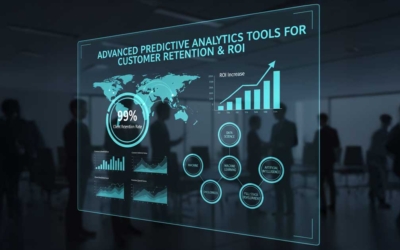The future of engineering design trends shaping the next decade with nearshore influence showcases the transformative impact of AI, AR/VR, generative design, and more. Explore how these technologies, coupled with the advantages of nearshore collaboration, will enhance efficiency, quality, and innovation in engineering design.
Key Takeaways
- Emerging technologies such as AI, AR, and VR are revolutionizing engineering design, enabling automation, enhanced collaboration, and innovative solutions.
- Nearshore development enhances project collaboration and quality outcomes, providing cost-effective access to specialized talent essential for competitive design.
- The rise of low-code platforms and continuous delivery methods significantly accelerates the engineering design process, promoting efficiency and adaptability across projects.
Emerging technologies in engineering design
Emerging technologies such as AI and machine learning are transforming the engineering design landscape through automation and innovative applications. These advancements empower engineers to create designs that are both more efficient and sustainable. Generative design AI, for instance, leverages algorithms to explore various design possibilities based on defined parameters, leading to innovative solutions.
Additionally, augmented reality (AR) and virtual reality (VR) are enhancing collaboration and creating immersive experiences in engineering design. These technologies allow teams to interact with 3D models and environments in real-time, making the design process more interactive and engaging. Integrating these technologies ushers in a new era of product innovation and efficiency.
Artificial Intelligence in design
Artificial intelligence (AI) is revolutionizing the design process by automating tasks, optimizing designs, and enabling innovations. Through automation and optimization, AI can significantly reduce the time and labor involved in repetitive design tasks. This allows engineers to focus on more creative and high-value aspects of the design process, leading to more innovative designs.
Generative design uses AI to create multiple design alternatives based on specific parameters and performance goals. This approach often results in lighter, stronger, and more efficient structures compared to traditional methods. AI allows designers to explore numerous possibilities, ultimately creating optimized designs that meet various goals.
Augmented and virtual reality applications
AR and VR offer immersive design experiences, enabling teams and clients to interact with 3D models and environments. This not only enhances the design process but also improves collaboration by enabling virtual meetings and remote participation in design discussions. Such technologies simplify the communication of complex ideas and visualization of the final product before construction.
Moreover, AR and VR enhance problem-solving capabilities by providing simulations for engineering scenarios, aiding in decision-making and training in critical situations. For example, engineers can use VR applications to simulate the performance of a structure under various conditions, allowing for more informed decisions and innovative solutions.
Nearshore influence on engineering design
Nearshore development enhances engineering design through easy collaboration, thanks to similar time zones and cultural affinities. This proximity facilitates better communication and project management, leading to higher quality outcomes. Nearshore companies bring specialized skills that align with project requirements, bridging the gap between offshore efficiencies and the need for close collaboration.
Furthermore, nearshoring offers additional advantages like cost-effectiveness. Leveraging nearshore development, businesses achieve financial efficiency while accessing top talent and specialized expertise. This combination leads to innovative designs and optimized solutions that are critical in today’s competitive market.
Cost-effective solutions
Nearshore software development offers significant cost savings compared to onshore options while still delivering high-quality services. The financial benefits of nearshoring include reduced costs and improved time to market, making it an attractive option for businesses. This allows companies to allocate resources more effectively, focusing on core activities and completing projects more efficiently.
Nearshoring enables firms to achieve financial efficiency and rapid project delivery, crucial in today’s competitive market. Adopting cost-effective software development solutions from nearshore partners drives product innovation and maintains a competitive edge.
Access to top talent
Nearshore regions provide access to experienced professionals and qualified candidates, enhancing the quality of design outcomes. Particularly in Latin America, there is a growing pool of highly skilled software developers, which significantly boosts project quality. This influx of top talent allows companies to meet their performance goals more effectively.
Around 9,600 new programmer openings are projected annually over the next decade, reflecting high demand for skilled talent. By tapping into this talent pool, businesses can leverage specialized skills and expertise to achieve innovative designs and optimized solutions.
Generative design and its future impact
Generative design reshapes engineering by enabling the rapid exploration of numerous design alternatives and optimizing performance goals. Generative design offers innovative, efficient, and sustainable designs, enhancing the optimization of concepts and layouts. This approach accelerates the design process and leads to superior product innovation.
Technologies such as 3D printing and IoT significantly enhance the capabilities of generative design, enabling refined and realized prototypes. McKinsey projects that generative AI will generate a productivity value of $2.6 to $4.4 trillion, indicating its substantial economic impact in the future. As these technologies evolve, generative design’s future impact on engineering will be profound.
Generative design AI capabilities
AI-driven generative design tools automate the generation of design options while optimizing for specific constraints. By utilizing AI and machine learning techniques, generative design significantly enhances the design process, leading to innovative and efficient structures. This allows designers to explore a wide array of possibilities quickly and efficiently.
Generative design optimizes by considering factors like materials, manufacturing processes, and performance requirements. AI in generative design enables optimal material reduction while maintaining structural integrity, resulting in cost-effective solutions. This approach benefits design engineers by replacing mundane work with high-value design objectives.
Rapid prototyping with generative design
Generative design is a transformative approach that rapidly generates and evaluates multiple design alternatives, significantly impacting the prototyping phase. Generative design automates processes and explores alternatives swiftly, reducing design time and allowing faster iterations during prototyping. This leads to rapid prototyping and accelerated product innovation, making engineers more productive.
Low-code platforms facilitate rapid prototyping by enabling teams to quickly prototype and launch applications with minimal coding expertise. This approach significantly reduces the time from concept to market, enabling businesses to stay ahead in a competitive environment.
Trends in low-code development for engineering
The rise of low-code platforms in engineering is leading to significant changes in how projects are developed and managed. These platforms facilitate faster development cycles, allowing engineering teams to deliver projects more efficiently. Low-code development enables engineers to create applications with minimal coding expertise, democratizing the development process.
As low-code platforms gain popularity, they become essential tools for a software development company. These platforms allow software developers to focus on high-value tasks, enhancing productivity and innovation. This trend is reshaping the landscape of software development, making it more accessible and efficient.
Benefits of low-code platforms
Low-code platforms streamline the design process by enabling faster application development, allowing engineers to create solutions without extensive coding skills. Open-source low-code solutions promote faster collaboration among teams while enhancing scalability and security. This approach not only increases efficiency but also ensures that projects can adapt to changing requirements more easily.
Role-based access control in low-code platforms helps maintain security while allowing team members to perform essential tasks. By 2024, the no-code and low-code technologies market is projected to reach approximately $26.9 billion, indicating significant industry investment. This growth reflects the increasing reliance on low-code platforms for efficient and secure software development.
Adoption in various sectors
Low-code development is being adopted in various sectors, including manufacturing, architecture, and consumer goods. Nearly 20% growth is projected for the no-code and low-code technologies market compared to 2022. This widespread adoption highlights the versatility and effectiveness of low-code platforms across different industries.
By the end of 2024, the no-code and low-code technologies market is expected to reach $26.9 billion. This significant market growth indicates that businesses are increasingly turning to low-code solutions to meet their development needs. As more industries embrace low-code development, the impact on engineering design will continue to grow.
Cloud computing and collaboration tools
Cloud computing allows teams to collaborate seamlessly from various locations, improving the overall efficiency of engineering processes. Cloud-native engineering collaboration software enhances teamwork by enabling real-time access and seamless sharing of design data among distributed teams. These tools are essential for modern software development, enabling teams to collaborate more effectively.
Low-code platforms enhance collaboration by allowing both technical and non-technical team members to contribute effectively. The efficient automation of workflows facilitated by these platforms enhances productivity and reduces manual errors. Together, cloud computing and low-code platforms are transforming the way engineering teams collaborate and innovate.
Enhanced collaboration tools
Advanced collaboration tools enable teams to work together in real-time from different countries, enhancing remote work capabilities. These tools support various forms of communication and project management, leading to improved efficiency and productivity among distributed teams. Advanced collaboration tools allow companies to access talented developers across nine time zones, maximizing project efficiency and output.
These tools enhance team members’ communication skills, enabling more effective collaboration. This is particularly important for software development companies that rely on seamless communication and collaboration to deliver high-quality projects. As these tools evolve, they will play an increasingly vital role in the success of engineering projects.
Scalability and flexibility
Cloud solutions provide easy scalability, allowing businesses to adjust resource allocation based on ongoing project requirements and market dynamics. This flexibility supports businesses in adapting resources to meet dynamic project changes efficiently. Scalability and flexibility in cloud-based solutions enable businesses to navigate changes in project requirements effectively.
The ability to quickly scale operations according to shifting project requirements and market conditions is a significant advantage of cloud-based solutions. This ensures that businesses can maintain high levels of efficiency and productivity, even as projects evolve.
As cloud technology continues to advance, its role in engineering design will become even more critical.
The role of continuous delivery in engineering design
Continuous delivery promotes ongoing feedback and rapid changes in engineering design. This method is defined by rapid iteration and constant improvement, essential for modern engineering projects. Cloud-based solutions enable multiple users to work on designs simultaneously, significantly reducing delays associated with traditional file-sharing methods.
Tools like Slack and Trello enable real-time collaboration, allowing teams to manage tasks and communicate effectively regardless of location. Advanced collaboration software enhances productivity by providing instant access to projects and facilitating asynchronous work.
Continuous delivery in engineering design promotes efficiency and adaptability across project workflows.
Agile methodologies
Agile methodologies prioritize iterative development and quick responses to user feedback. This approach promotes iterative development, enabling teams to respond quickly and effectively to client feedback. Dividing large projects into smaller tasks, Agile methodologies enhance efficiency and keep projects on track.
Iterative development allows constant testing and adaptation of designs based on user feedback. This constantly evolving improvement cycle ensures the final product meets the user’s needs and expectations.
Agile methodologies are a cornerstone of modern software development, fostering innovation and flexibility in the design process.
Integration with emerging technologies
The combination of continuous delivery with advanced technologies like AI enhances both the quality and efficiency of design processes. Continuous delivery is a modern approach that emphasizes rapid iteration and constant improvement in engineering design processes. By integrating continuous delivery with AI, engineering teams can achieve significant improvements in design quality through automated optimizations.
Using continuous delivery alongside machine learning enhances efficiency in design workflows. This integration seamlessly incorporates new technologies, ensuring engineering projects stay at the cutting edge of innovation. As emerging technologies continue to evolve, their integration with continuous delivery will further transform engineering design.
Throughout this exploration of the future of engineering design, we have seen how emerging technologies, nearshore development, and innovative methodologies are reshaping the field. From the transformative power of generative design AI to the collaborative potential of cloud computing, these advancements are driving efficiency, creativity, and innovation in engineering.
As we look to the next decade, it is clear that the integration of advanced technologies and agile methodologies will continue to push the boundaries of what is possible in engineering design. By embracing these trends, engineers and designers can create optimized, sustainable, and groundbreaking solutions that meet the ever-evolving demands of the market. The future of engineering design is bright, and the possibilities are endless.
Frequently Asked Questions
How is AI impacting the engineering design process?
AI is transforming the engineering design process by automating repetitive tasks and optimizing designs, which allows engineers to dedicate more time to innovative and creative aspects of their work. This shift not only enhances efficiency but also fosters greater innovation in engineering solutions.
What are the benefits of nearshore development in engineering design?
Nearshore development provides cost-effective solutions, fosters collaboration through similar time zones, and grants access to specialized skills, resulting in higher design quality and improved financial efficiency.
How does generative design AI enhance the design process?
Generative design AI significantly enhances the design process by automating the creation of various design alternatives tailored to specific parameters and performance goals, leading to more innovative and optimized solutions. Thus, it fosters creativity and efficiency in design outcomes.
What role do low-code platforms play in engineering?
Low-code platforms significantly accelerate development cycles, enabling engineers to build applications with minimal coding skills. This approach fosters collaboration and improves overall efficiency in engineering projects.
How do cloud computing and collaboration tools improve engineering design?
Cloud computing and collaboration tools significantly enhance engineering design by facilitating seamless collaboration and real-time communication among distributed teams, which results in improved efficiency and productivity. This interconnected approach allows for more effective project management, ultimately leading to better design outcomes.






0 Comments